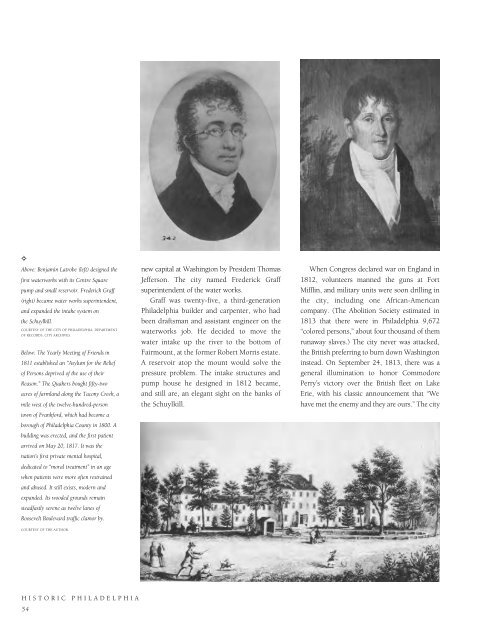Historic Philadelphia
An illustrated history of the city of Philadelphia, paired with the histories of companies, families and organizations that make the region great.
An illustrated history of the city of Philadelphia, paired with the histories of companies, families and organizations that make the region great.
You also want an ePaper? Increase the reach of your titles
YUMPU automatically turns print PDFs into web optimized ePapers that Google loves.
✧<br />
Above: Benjamin Latrobe (left) designed the<br />
first waterworks with its Centre Square<br />
pump and small reservoir. Frederick Graff<br />
(right) became water works superintendent,<br />
and expanded the intake system on<br />
the Schuylkill.<br />
COURTESY OF THE CITY OF PHILADELPHIA, DEPARTMENT<br />
OF RECORDS, CITY ARCHIVES.<br />
Below: The Yearly Meeting of Friends in<br />
1811 established an “Asylum for the Relief<br />
of Persons deprived of the use of their<br />
Reason.” The Quakers bought fifty-two<br />
acres of farmland along the Tacony Creek, a<br />
mile west of the twelve-hundred-person<br />
town of Frankford, which had become a<br />
borough of <strong>Philadelphia</strong> County in 1800. A<br />
building was erected, and the first patient<br />
arrived on May 20, 1817. It was the<br />
nation’s first private mental hospital,<br />
dedicated to “moral treatment” in an age<br />
when patients were more often restrained<br />
and abused. It still exists, modern and<br />
expanded. Its wooded grounds remain<br />
steadfastly serene as twelve lanes of<br />
Roosevelt Boulevard traffic clamor by.<br />
COURTESY OF THE AUTHOR.<br />
new capital at Washington by President Thomas<br />
Jefferson. The city named Frederick Graff<br />
superintendent of the water works.<br />
Graff was twenty-five, a third-generation<br />
<strong>Philadelphia</strong> builder and carpenter, who had<br />
been draftsman and assistant engineer on the<br />
waterworks job. He decided to move the<br />
water intake up the river to the bottom of<br />
Fairmount, at the former Robert Morris estate.<br />
A reservoir atop the mount would solve the<br />
pressure problem. The intake structures and<br />
pump house he designed in 1812 became,<br />
and still are, an elegant sight on the banks of<br />
the Schuylkill.<br />
When Congress declared war on England in<br />
1812, volunteers manned the guns at Fort<br />
Mifflin, and military units were soon drilling in<br />
the city, including one African-American<br />
company. (The Abolition Society estimated in<br />
1813 that there were in <strong>Philadelphia</strong> 9,672<br />
“colored persons,” about four thousand of them<br />
runaway slaves.) The city never was attacked,<br />
the British preferring to burn down Washington<br />
instead. On September 24, 1813, there was a<br />
general illumination to honor Commodore<br />
Perry’s victory over the British fleet on Lake<br />
Erie, with his classic announcement that “We<br />
have met the enemy and they are ours.” The city<br />
HISTORIC PHILADELPHIA<br />
54
















